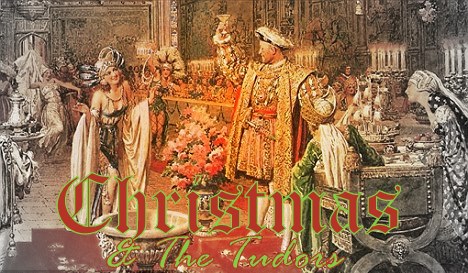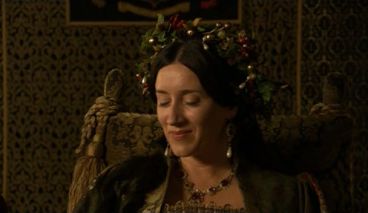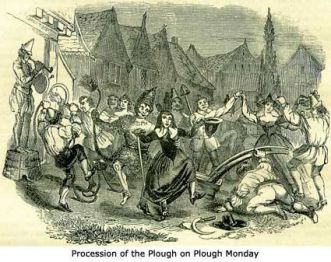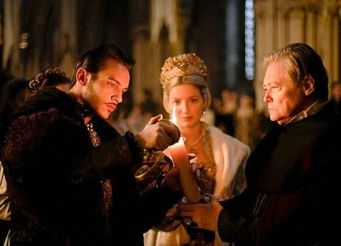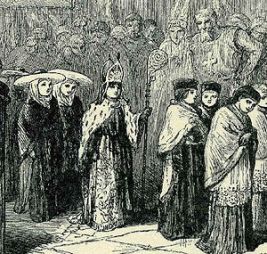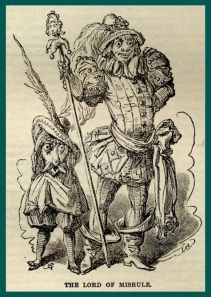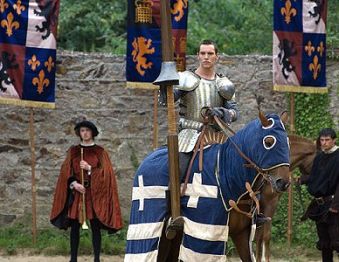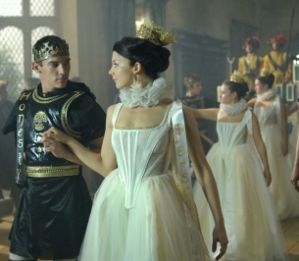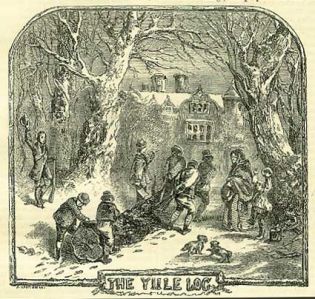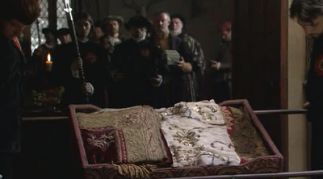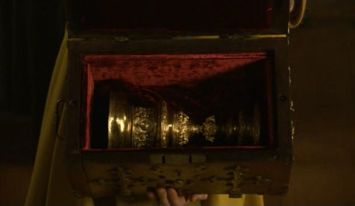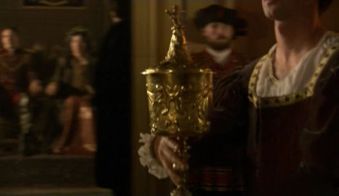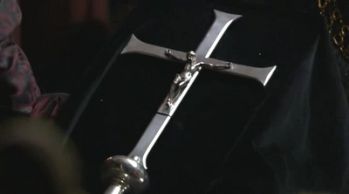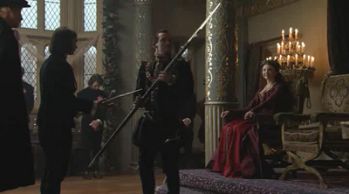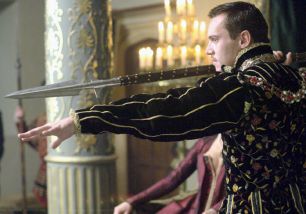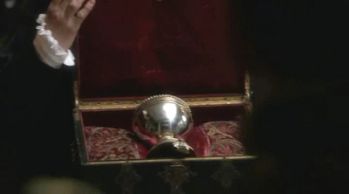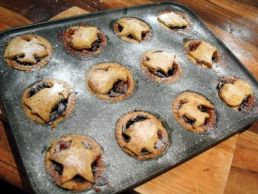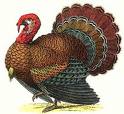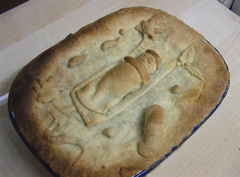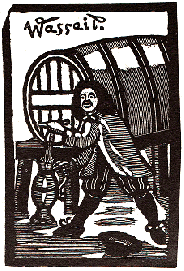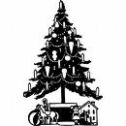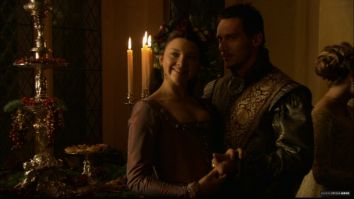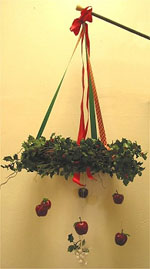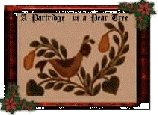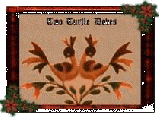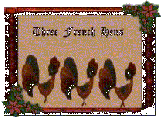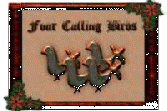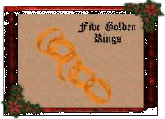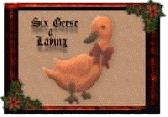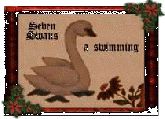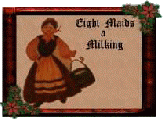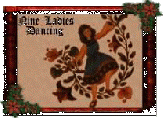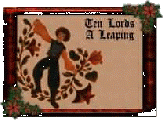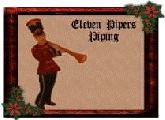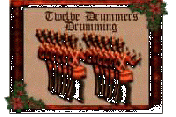CHRISTMAS with The Tudors
Jump to navigation
Jump to search
| <embed allowfullscreen="true" height="350" src="http://widget.wetpaintserv.us/wiki/thetudorswiki/widget/youtubevideo/43185aa5a96e89425149d7d3faaaf41ff8668ebe" type="application/x-shockwave-flash" width="425" wmode="transparent"/> |
| Tudor Christmas Traditions | Christmas on the Tudors Series |
 Christmas was the greatest festival celebrated by the Tudor's spanning twelve days from December 25th to January 6th. Most of these twelve days were Saint's Days with the most important ones being Dec. 25th, Jan. 1st, and Jan 6th, which is when the greatest feasts and celebrations were held. Some fasting was required in preparation for the festival, in particular on Christmas Eve when no meat, eggs, or cheese could be eaten. Christmas was the greatest festival celebrated by the Tudor's spanning twelve days from December 25th to January 6th. Most of these twelve days were Saint's Days with the most important ones being Dec. 25th, Jan. 1st, and Jan 6th, which is when the greatest feasts and celebrations were held. Some fasting was required in preparation for the festival, in particular on Christmas Eve when no meat, eggs, or cheese could be eaten. | Queen Katherine of Aragon in her Christmas Regalia |
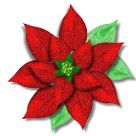 Throughout the twelve days of Christmas all work was halted except for the care of animals. Even spinning which was the major occupation of women was stopped and their still spinning wheels were surrounded by flowers. People would use this time to visit friends and partake in community celebration. All work would resume on Plough Monday, the first Monday following the twelfth night. Throughout the twelve days of Christmas all work was halted except for the care of animals. Even spinning which was the major occupation of women was stopped and their still spinning wheels were surrounded by flowers. People would use this time to visit friends and partake in community celebration. All work would resume on Plough Monday, the first Monday following the twelfth night. | |
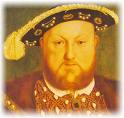 The Monarch had several obligations during the festival. When the celebrations began on Christmas Day he was required to attend Mass three times and he was also expected to be wearing new clothes. He would proceed from his Privy Chamber to the Royal Chapel dressed in coronation robes and crown. During these masses, the genealogy of Christ was sung while everybody held lighted candles. The Monarch had several obligations during the festival. When the celebrations began on Christmas Day he was required to attend Mass three times and he was also expected to be wearing new clothes. He would proceed from his Privy Chamber to the Royal Chapel dressed in coronation robes and crown. During these masses, the genealogy of Christ was sung while everybody held lighted candles. | |
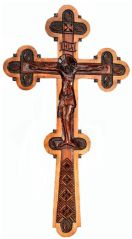 Tudor society was very strictly organised and so the festivities of a Tudor Christmas served to release some of these pressures. Things were turned inside out and upside down, allowing some sections of society unusual freedoms. One such tradition was the practice some communities had of electing a choir boy or alter boy as "boy bishop" on either the 6th or the 28th of December. This practice was to show the boy the honor and dignity of Holy Orders. As boy bishop he would assume all the duties of the Bishop except taking Mass, but he would preach a sermon and go on parishioner visits. Tudor society was very strictly organised and so the festivities of a Tudor Christmas served to release some of these pressures. Things were turned inside out and upside down, allowing some sections of society unusual freedoms. One such tradition was the practice some communities had of electing a choir boy or alter boy as "boy bishop" on either the 6th or the 28th of December. This practice was to show the boy the honor and dignity of Holy Orders. As boy bishop he would assume all the duties of the Bishop except taking Mass, but he would preach a sermon and go on parishioner visits.In 1541 King Henry VIII banned this practice because it was mocking church authorities and the head of the church who was King Henry. The practice has never completely died out and is still practiced in some areas to this day. | Boy Bishop being attended by his Canons (sorry, no series photo available) |
| Another tradition during Tudor times was to appoint a Lord of Misrule, who was like a mock King and would oversee entertainments or unruly events involving drinking, revelry, role reversal and general chaos. The person chosen to be Lord of Misrule was appointed by the head of the Parish, but the King had his own personal one. His "rule" ended on the Twelfth Night. Another example of role reversal which originated during the Tudor period was Barring Out. This involved students taking possession of their school and locking out the staff until their "ransom" demands were met. | The Lord of Misrule (sorry, no series photo available) |
| All sports were banned on Christmas day by Henry VIII in 1541. The exception to this was archery and of course jousting, which was very popular during the Christmas season. | Henry preparing for the joust. |
 Another Christmas tradition was the performance of plays. From the early 16th century both Oxford and Cambridge colleges employed travelling players in their productions."Mumming" was where actors performed their plays and dances in villages and castles. Mystery plays were also performed in which the story of Christ was told. Many productions were morality plays where the actors were dressed as virtues, but an evolution during the Tudor reign started to include various games and song and dance. Another Christmas tradition was the performance of plays. From the early 16th century both Oxford and Cambridge colleges employed travelling players in their productions."Mumming" was where actors performed their plays and dances in villages and castles. Mystery plays were also performed in which the story of Christ was told. Many productions were morality plays where the actors were dressed as virtues, but an evolution during the Tudor reign started to include various games and song and dance. | Henry and Anne at the Masquerade where they portrayed virtues "Honesty" and "Perseverance". |
| The burning of the Yule Log is thought to derive from the midwinter ritual of early Viking invaders, who built large bonfires to celebrate their festival of light. The word "Yule" has existed in the English language for many centuries as an alternative term for Christmas. Traditionally a large log would be selected from the forest on Christmas Eve, and decorated with ribbons, dragged home and laid upon the hearth. After lighting it was kept burning throughout the twelve days of Christmas. It was considered lucky to keep some of the charred remains to kindle the log of the following year. | (sorry, no series photo available) |
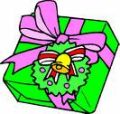 Unlike our tradition of exchanging gifts on Christmas Day, the Tudors had their gift exchange on New Year's Day. Everyone of any importance was expected to give the King a gift and would, in turn, receive one. Acceptance or rejection of a gift was very important; for example, in 1532 Henry VIII accepted Anne Boleyn's gift but rejected Katherine of Aragon's, and the following year Anne and Henry were married. Unlike our tradition of exchanging gifts on Christmas Day, the Tudors had their gift exchange on New Year's Day. Everyone of any importance was expected to give the King a gift and would, in turn, receive one. Acceptance or rejection of a gift was very important; for example, in 1532 Henry VIII accepted Anne Boleyn's gift but rejected Katherine of Aragon's, and the following year Anne and Henry were married.Epigrams were often sent as gifts. They usually consisted of 1 or 2 verses and were quite often sarcastic or satirical. | 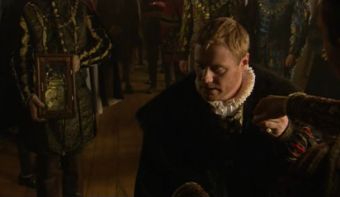 Edward Stafford, 3rd Duke of Buckingham brings the Royal couple, King Henry & Queen Katherine, a gift of a clock |
 Gift giving and receiving was so important that all gifts that were kept were listed in a Gift Roll. This list would include the record of the ladies of Henry's court giving him embroidered shirts. Craftsmen would also give gifts reflective of their talents: for example, Hans Holbein once gave Henry a portrait painting of Prince Edward as a Christmas gift. Gift giving and receiving was so important that all gifts that were kept were listed in a Gift Roll. This list would include the record of the ladies of Henry's court giving him embroidered shirts. Craftsmen would also give gifts reflective of their talents: for example, Hans Holbein once gave Henry a portrait painting of Prince Edward as a Christmas gift. | 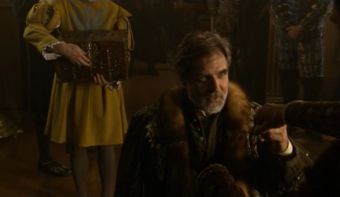 Thomas Howard, 3rd Duke of Norfolk comes bearing gifts for Queen Katherine & King Henry |
| Henry's gift of materials for Anne | Norfolk's Gift |
| Sir Thomas More's gift to Katherine & Henry | |
| Anne Boleyn's Gift to Henry of a spear ( before their marriage) | The King tries out his gift |
| Gift of a Goblet which Katherine sends to Henry after her banishment and he returns it. | 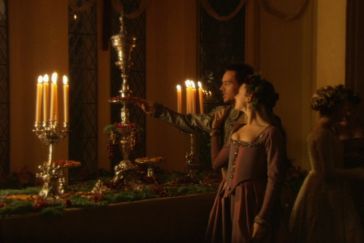 Queen Anne Boleyn shows Henry the famous Holbein designed "Boleyn cup" |
| |
| During the Twelve Days, people would visit their neighbours sharing and enjoying the traditional 'minced pye'. The pyes would have included thirteen ingredients, representing Christ and his apostles, typically dried fruits, spices and of course a little chopped mutton - in remembrance of the shepherds. | Minced pies |
| Serious feasting would have been the reserve of Royalty and the Gentry. Turkey was first introduced into Britain in about 1523 with Henry VIII being one of the first people to eat it as part of the Christmas feast. The popularity of the bird grew quickly, and soon, each year, large flocks of turkeys could be seen walking to London from Norfolk, Suffolk and Cambridgeshire on foot; a journey which they may have started as early as August. | |
| A Tudor Christmas Pie was indeed a sight to behold but not one to be enjoyed by a vegetarian. The contents of this dish consisted of a Turkey stuffed with a goose stuffed with a chicken stuffed with a partridge stuffed with a pigeon. All of this was put in a pastry case, called a coffin and was served surrounded by jointed hare, small game birds and wild fowl. | |
| And to wash it all down, a drink from the Wassail bowl. The word 'Wassail' derives from the Anglo-Saxon 'Waes-hael', meaning 'be whole' or 'be of good health'. The bowl, a large wooden container holding as much as a gallon of punch made of hot-ale, sugar, spices and apples. This punch to be shared with friends and neighbours. A crust of bread was placed at the bottom of the Wassail bowl and offered to the most important person in the room - hence today's toast as part of any drinking ceremony. |
| <embed height="254" src="http://widget.wetpaintserv.us/wiki/thetudorswiki/page/The+Tudors+%26+Christmas/widget/youtubevideo/1c9bdd2b30dc5cca4db3ab4dfdba4c0b1d165896" type="application/x-shockwave-flash" width="332" wmode="transparent"/> Medieval Christmas at the Tower of London Posted by <a class="external" href="http://www.youtube.com/user/HistoricRoyalPalaces" rel="nofollow" target="_blank">HistoricRoyalPalaces</a> Jan 2009 At the Tower of London this festive season we partied like it was 1284! Heres a selection of the medieval merriment that was on offer including carols, soldiers songs, an exquisite feast and a personal greeting from a nun and bishop! | <embed height="254" src="http://widget.wetpaintserv.us/wiki/thetudorswiki/page/The+Tudors+%26+Christmas/widget/youtubevideo/6d644b09087b2eb74a784d2c4d3f494e8e56df4c" type="application/x-shockwave-flash" width="332" wmode="transparent"/> Tudor Christmas at Hampton Court Palace Posted by <a class="external" href="http://www.youtube.com/user/HistoricRoyalPalaces" rel="nofollow" target="_blank">HistoricRoyalPalaces</a> Jan 2009 For those who haven't been able to join us, here's a selection of the Tudor fun that's been on offer at Hampton Court Palace over the festive season, including some unusual Tudor facts, much singing and music - and a fire breathing fool! |
| |
| |
